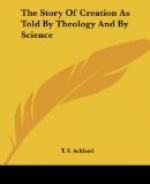5. The earliest traces of man—flint implements—are found in the Post Tertiary strata.
We have then in the Mosaic narrative five points which correspond in order and character to five points in the Geological record; and with reference to two, at least, of these points, we cannot imagine any cause for the coincidence in the shape of a fortunate conjecture, because, so far as we can tell, there was nothing apparent on the face of the earth to suggest to the mind of the writer the long past existence of such a state of things as has been revealed to us by the discovery of the Carboniferous and Reptilian remains. It seems then that Moses must have been in possession of information which could not be obtained from any ordinary source. But if he was thus acquainted with the order in which the development took place, there is nothing improbable in the supposition that he was not altogether ignorant of the length of time which that development required.
Let us suppose then that his knowledge did extend a little farther; let us suppose him to have been aware that each of the Creations which he describes was a process occupying many thousands of years—how could he have imparted this knowledge to his readers? What modification could he have introduced into his narrative, which without changing its general character, or detracting from its extreme simplicity, should have embodied this fact?
This amounts to the question: What words significant of definite periods of time were in use, and consequently at the writer’s command, at this time? No language is very rich in such words; but in the early Hebrew they seem to have been very scanty. The day, week, month, year, and generation (this last usually implying the time from the birth of a man to that of his son, but possibly in Gen. xv. 16, a century) are all that we find. These in their literal sense were evidently inadequate. Nor could the deficiency be supplied by numerals, even if the general style of the narrative would have admitted their use, for we find in Genesis no numeral beyond the thousand. There was no word at all in early Hebrew equivalent to our words “period” and “season.” When such an idea was to be expressed, it was done by the use of the word “day,” either in the singular, or more commonly in the plural. Thus, “the time of harvest;” “the season of the first ripe fruit,” are literally “the days of harvest,” “the days of the first ripe fruit.” In Isaiah xxxiv. 8, the singular is used, and followed by the word year in the same indefinite sense. “It is the day of the Lord’s vengeance, and the year of recompenses for the controversy of Zion.”
The only method then which was open to the writer was to make use of one of the words above mentioned in an extended sense, just as he used the word [Hebrew script] (earth) in several senses. But if one of them was to be employed, the one which he has chosen seems the best; not only because its use in that way was common, but because the brevity of the time covered by its natural significance would in itself be a hint of the way in which it was used. That which was impossible in a day might be possible in a year or a generation. The extended significance of the word would become apparent just in proportion as the time covered by its natural significance was inadequate for the processes ascribed to it.




